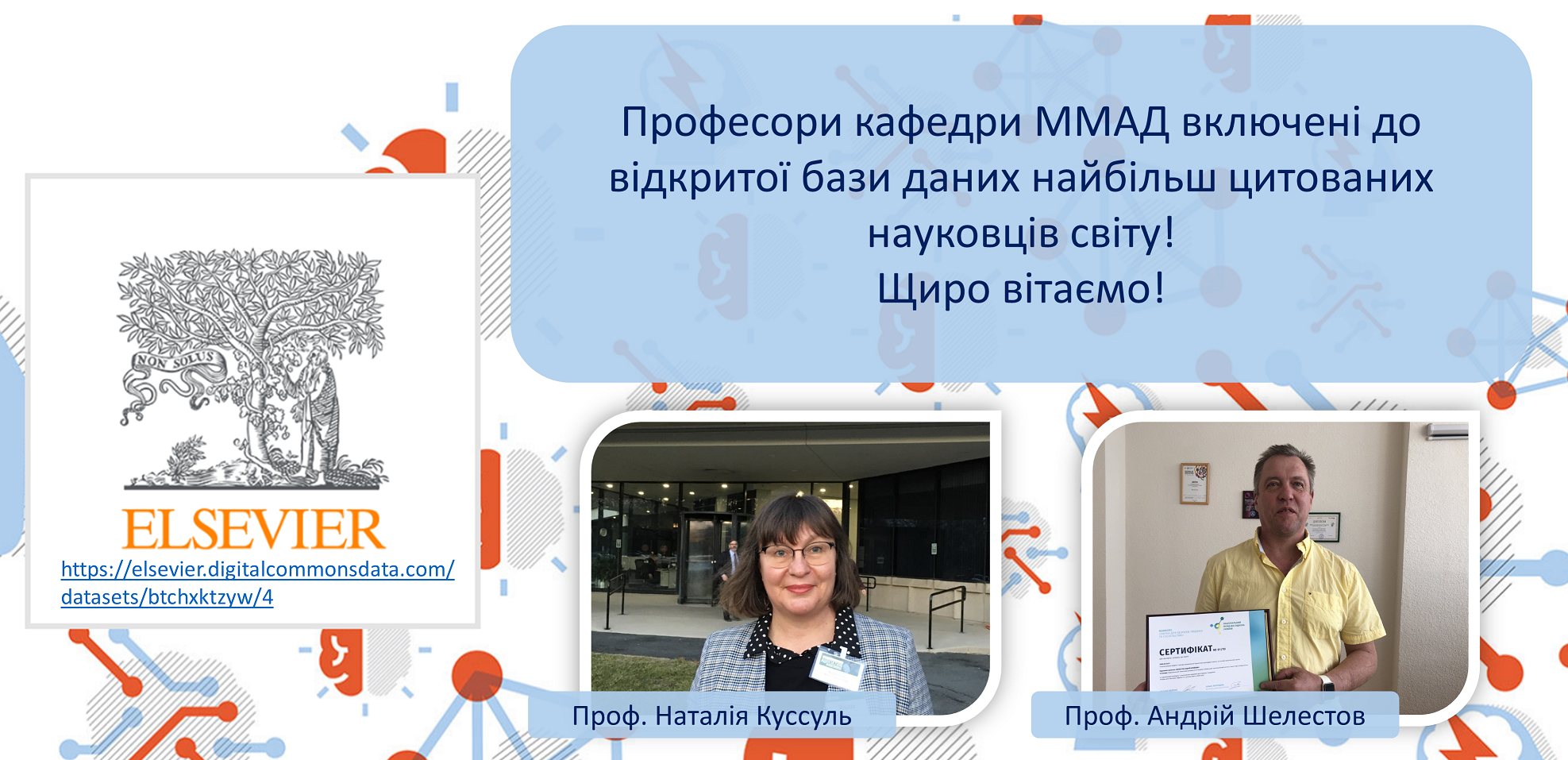On the International Day of Science, the MMDA department welcomes all scientists and is proud that two professors of our department, prof. Nataliia Kussul and prof. Andrii Shelestov, included in the open database of the world’s most cited scientists, created by Stanford University based on a standardized methodology that takes into account various citation indices, the influence of scientific publications where the works are published, and even the serial number of the author in the publication. At the same time, ratings are calculated without taking into account self-citation. In the database, indicators are calculated separately for the entire scientific career of the scientist and separately for one last year. Scientists are classified according to 22 scientific fields and 176 subfields. Prof. Natalia Kussul. According to the database, her main scientific field is “Artificial intelligence and image processing”. The list of the most cited scientists over the past year is wider, and among 108 Ukrainian scientists, Prof. Andrii Shelestov. His scientific direction is also defined as “Artificial intelligence and image processing”.
According to the version of Stanford University, among the 92 most cited scientists of all time in Ukraine, only two representatives of NTUU “Igor Sikorsky Kyiv Polytechnic Institute” (Prof. V.M. Loktev and Prof. N.M. Kussul) are among the 108 most cited Ukrainian scientists in the last year seven scientists of NTUU “Igor Sikorsky Kyiv Polytechnic Institute” (List of the best Ukrainian scientists for the entire career, List of the best Ukrainian scientists for 1 year).
For comparison, each of the rating lists includes about 200,000 world scientists. Among them are only about 100 scientists who worked during their careers or are working in Ukraine, and more than 400 scientists from the University of Maryland (UMD) alone, with which the department cooperates. We are proud that among the most cited scientists of UMD in the last year, there is a graduate of physics and engineering prof. Sergey Skakun.
Here is a citation of the article “September 2022 data-update for “Updated science-wide author databases of standardized citation indicators”” published by representatives of Stanford University on October 10 (https://elsevier.digitalcommonsdata.com/datasets/btchxktzyw/4 , DOI:10.17632 /btchxktzyw.4). This article also contains links to complete ranking lists of the world’s most cited scientists.
Citation metrics are widely used and misused. We have created a publicly available database of top-cited scientists that provides standardized information on citations, h-index, co-authorship adjusted hm-index, citations to papers in different authorship positions and a composite indicator (c-score). Separate data are shown for career-long and, separately, for single recent year impact. Metrics with and without self-citations and ratio of citations to citing papers are given. Scientists are classified into 22 scientific fields and 176 sub-fields. Field- and subfield-specific percentiles are also provided for all scientists with at least 5 papers. Career-long data are updated to end-of-2021 and single recent year data pertain to citations received during calendar year 2021. The selection is based on the top 100,000 scientists by c-score (with and without self-citations) or a percentile rank of 2% or above in the sub-field. 195,605 scientists are included in the career-long database and 200,409 scientists are included in the single recent year dataset. This version (4) is based on the Sept 1, 2022 snapshot from Scopus, updated to end of citation year 2021. This work uses Scopus data provided by Elsevier through ICSR Lab (https://www.elsevier.com/icsr/icsrlab).
Calculation were performed using all Scopus author profiles as of September 1, 2022. If an author is not on the list it is simply because the composite indicator value was not high enough to appear on the list. It does not mean that the author does not do good work. Please also note that the database has been published in an archival form and will not be changed. The published version accurately reflects Scopus author profiles at the time of calculation. Some authors may not appear on the list if their Scopus profile was inaccurate (missing publications and citations) at the time of calculation. We thus advise authors to ensure that their Scopus profiles are accurate. Requests for corrections of the Scopus data should not be sent to us. They should be sent directly to Scopus, preferably by use of the Scopus to ORCID feedback wizard (https://orcid.scopusfeedback.com/) so that the correct data can be used in any future annual updates of the citation indicator databases.
The c-score focuses on impact (citations) rather than productivity (number of publications) and it also incorporates information on co-authorship and author positions (single, first, last author). If you have additional questions, please read the 3 associated papers published in PLoS Biology that explain the development, validation and use of these metrics and databases. (https://doi.org/10.1371/journal.pbio.1002501, https://doi.org/10.1371/journal.pbio.3000384 and https://doi.org/10.1371/journal.pbio.3000918).
Finally, we alert users that all citation metrics have limitations and their use should be tempered and judicious. For more reading, we refer to the Leiden manifesto: https://www.nature.com/articles/520429a
Once again, we congratulate all scientists of Ukraine on the International Day of Science and wish them new successes and victories, as well as Victory to all of us!

